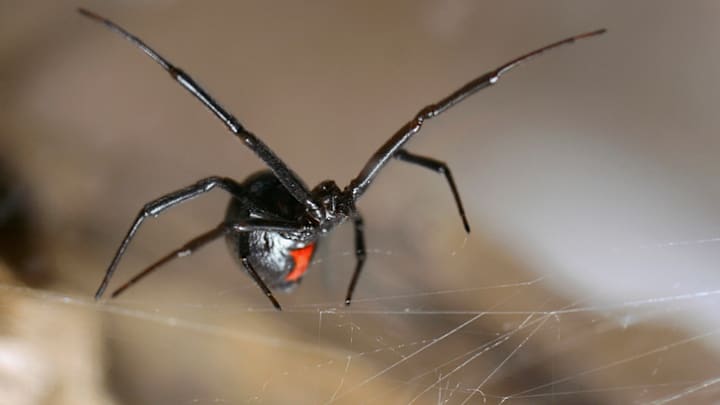Whether you love spiders or have full-blown arachnophobia, you can appreciate the charisma of the black widow, known for its unique appearance and venomous bite. But there is more to these eight-legged creatures than meets the eye. Here are some intriguing facts about the dynamic arachnids.
1. Black widow spiders aren’t always black.
Contrary to their name, not all black widow spiders are entirely black with a reddish hourglass mark on their abdomens. While females of most black widow species possess the characteristic glossy black color, they can also exhibit shades of dark brown or gray. Males usually have a brown or gray body with red, yellow, or white spots or bands on their abdomens. This variation in coloring means that black widow spiders can be tricky to spot if they aren’t black and red females.
2. Only female spiders bite … usually.
While both male and female black widows possess venom glands, the spiders are not considered aggressive and will bite only when they feel threatened. Males are more reclusive than females and rarely need to bite humans to defend themselves. Although you are more likely to come across a female black widow, you are still unlikely to be bitten unless you disturb it.
3. There are over 30 species of widow spiders.

Black widows belong to the genus Latrodectus, which includes 34 species worldwide. The most familiar species is the western black widow (L. hesperus), found in western regions of North America. Other species include the northern black widow (L. variolus) and the southern black widow (L. mactans). They all contain similar markings and the females bear the hourglass symbol on their abdomen, although the species’ shapes and colors can vary.
4. Black widow spiderlings don’t look like the adults.
When black widow spider eggs hatch, the spiderlings (baby spiders) that emerge look very different from mom or dad. They have unique patterns and coloration, often displaying white or yellowish markings on their bodies. Western black widow spiderlings, for example, are brown with a white, black-spotted abdomen. As baby black widows mature, their appearance gradually changes, and the females eventually develop the iconic black bodies and hourglasses.
5. Their venom is about 15 times as toxic as a prairie rattlesnake’s venom.
Many people are wary of black widow spiders because of their venomous bites. This comes with good reason—it is estimated that black widow venom is about 15 times as potent as the venom of a prairie rattlesnake. However, the quantity of venom injected during a spider bite is significantly smaller than that of a snake bite, making black widow bites generally less dangerous to humans.
6. Black widow bites are serious but rarely fatal.

Black widow bites are painful and can cause severe symptoms, but fatalities are rare. Most bites result in local pain, redness, and swelling. Within an hour, bite victims will often feel muscle pain throughout their entire body. Without prompt treatment, other symptoms may include difficulty breathing, high blood pressure, nausea, and muscle cramps. Children, older people, and those with compromised immune systems may experience more severe reactions, including muscle spasms and seizures. All black widow spider bites should be treated by a medical professional as soon as possible.
7. They use “tangle webs” to catch their prey.
Black widow spiders are skilled weavers and create intricate webs to catch their prey. Unlike the symmetrical webs that many arachnids spin, black widows build irregular, messy-looking webs known as “tangle webs.” These structures are highly effective in ensnaring insects and other small creatures that accidentally venture into them. They are also strong enough to safely hold a female spider’s egg sac, which is typically filled with hundreds of eggs.
8. Black widow spiders liquify their prey before eating it.
If you have a queasy stomach, read on at your own risk! When a mosquito, fly, beetle, or other bug gets trapped in a black widow web, the spider injects powerful digestive enzymes into their victim. This, combined with some masticating with their fangs, essentially liquefies the internal tissues of their captured dinner. The spider then sucks up the fluid, leaving behind nothing but an exoskeleton.
9. Males black widows are sometimes eaten after mating.

Ever wonder how black widows got their name? It comes from the females’ habit of eating male spiders after mating. Males are significantly smaller than females, which may make them seem like a tantalizing treat once mating has finished. Males may also be more willing to sacrifice themselves to females due to the evolutionary advantage it provides—getting eaten may leave extra sperm in the female, leading to more babies later on. But while this form of cannibalism definitely happens, it doesn’t occur nearly as often as many people assume.
10. Horses help produce antivenom for black widow spider bites.
Black widow spider bites can cause serious health issues in humans, but thanks to modern medicine, antivenom is available to counteract its effects. To create it, technicians inject small, controlled amounts of black widow spider venom into horses, triggering an immune response. The horses generate antibodies, which are then harvested and used to manufacture antivenom for human use.
